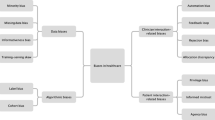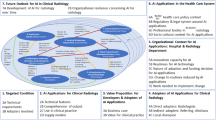Abstract
The public reporting of hospitals’ quality of care is providing additional motivation for hospitals to deliver high-quality patient care. Hospital Compare, a consumer-oriented website by the Centers for Medicare and Medicaid Services (CMS), provides patients with detailed quality of care data on most US hospitals. Given that many quality metrics are the aggregate result of physicians’ individual clinical decisions, the question arises if and how hospitals could influence their physicians so that their decisions positively contribute to hospitals’ quality goals. In this paper, we develop a decision-theoretic model to explore how three different hospital interventions—incentivization, training, and nudging—may affect physicians’ decisions. We focus our analysis on Outpatient Measure 14 (OP-14), which is an imaging quality metric that reports the percentage of outpatients with a brain computed tomography (CT) scan, who also received a same-day sinus CT scan. In most cases, same-day brain and sinus CT scans are considered unnecessary, and high utilizing hospitals aim to reduce their OP-14 metric. Our model captures the physicians’ imaging decision process accounting for medical and behavioral factors, in particular the uncertainty in clinical assessment and a physician’s diagnostic ability. Our analysis shows how hospital interventions of incentivization, training, and nudging affect physician decisions and consequently OP-14. This decision-theoretic model provides a foundation to develop insights for policy makers on the multi-level effects of their policy decisions.










Similar content being viewed by others
References
CMS. What is Hospital Compare? 2019; Available from: https://www.medicare.gov/hospitalcompare/About/What-Is-HOS.html.
Dor A, Encinosa WE, Carey K (2015) Medicare’s hospital compare quality reports appear to have slowed price increases for two major procedures. Health Aff 34(1):71–77
Blake RS, Clarke HD (2019) Hospital compare and hospital choice: public reporting and hospital choice by hip replacement patients in Texas. Med Care Res Rev 76(2):184–207
Narayan AK et al (2019) Trends in hospital performance on the medicare national outpatient imaging metrics: a 5-year longitudinal cohort analysis. In: Journal of the American College of Radiology
Beinfeld MT, Gazelle GS (2005) Diagnostic imaging costs: are they driving up the costs of hospital care? Radiology 235(3):934–939
Vance E et al (2013) Computed tomography scan use variation: patient, hospital, and geographic factors. Am J Manag Care 19(3):e93
Gawande, A (2009) The cost conundrum, in The New Yorker. p. 36–44.
Hendee WR et al (2010) Addressing overutilization in medical imaging. Radiology 257(1):240–245
Nahed BV et al (2012) Malpractice liability and defensive medicine: a national survey of neurosurgeons. PLoS One 7(6):e39237
Hoffman JR, Kanzaria HK (2014) Intolerance of error and culture of blame drive medical excess. BMJ 349:g5702
Kanzaria HK et al (2015) Emergency physician perceptions of medically unnecessary advanced diagnostic imaging. Acad Emerg Med 22(4):390–398
Marmot MG et al (2013) The benefits and harms of breast cancer screening: an independent review. Br J Cancer 108(11):2205
Baker RD (1998) Use of a mathematical model to evaluate breast cancer screening policy. Health Care Management Science 1(2):103–113
Maillart LM et al (2008) Assessing dynamic breast cancer screening policies. Oper Res 56(6):1411–1427
Ayer T, Alagoz O, Stout NK (2012) OR forum—a POMDP approach to personalize mammography screening decisions. Oper Res 60(5):1019–1034
Ivy J (2008) A maintenance model for breast cancer treatment and detection. Working paper, Edward P. Fitts Department of Industrial and Systems ….
Zhang H, Wernz C, Hughes DR (2018) Modeling and designing health care payment innovations for medical imaging. Health Care Management Science 21(1):37–51
Zhang H, Wernz C, Slonim AD (2016) Aligning incentives in health care: a multiscale decision theory approach. EURO Journal on Decision Processes 4(3):219–244
Wernz C, Deshmukh A (2007) Managing hierarchies in a flat world. in Proceedings of the 2007 Industrial Engineering Research Conference. Nashville, TN.
Wernz C (2008) Multiscale decision making: bridging temporal and organizational scales in hierarchical systems, in Mechanical and Industrial Engineering. University of Massachusetts Amherst, Dissertation
Wernz C, Deshmukh A (2009) An incentive-based, multi-period decision model for hierarchical systems. in Proceedings of the 3rd Annual Conference of the Indian Subcontinent Decision Sciences Institute Region (ISDSI). Hyderabad, India.
Wernz C, Deshmukh A (2010) Multiscale decision-making: bridging organizational scales in systems with distributed decision-makers. Eur J Oper Res 202(3):828–840
Wernz C, Deshmukh A (2012) Unifying temporal and organizational scales in multiscale decision-making. Eur J Oper Res 223(3):739–751
Wernz C (2013) Multi-time-scale Markov decision processes for organizational decision-making. EURO Journal on Decision Processes 1(3):299–324
Wernz C, Deshmukh A (2010). Multi-time-scale decision making for strategic agent interactions. in Proceedings of the 2010 Industrial Engineering Research Conference. Cancun, Mexico.
Wernz C, Deshmukh A (2007) Decision strategies and design of agent interactions in hierarchical manufacturing systems. J Manuf Syst 26(2):135–143
Henry A, Wernz C (2015) A multiscale decision theory analysis for revenue sharing in three-stage supply chains. Ann Oper Res 226(1):277–300
Wernz C, Henry A (2009) Multilevel coordination and decision-making in service operations. Serv Sci 1(4):270–283
Ozcan YA (1998) Physician benchmarking: measuring variation in practice behavior in treatment of otitis media. Health Care Management Science 1(1):5–17
Miao-Sheng C, Yu-Ti S (2008) Pricing of prescription drugs and its impact on physicians’ choice behavior. Health Care Management Science 11(3):288–295
Fügener A, Schiffels S, Kolisch R (2017) Overutilization and underutilization of operating rooms-insights from behavioral health care operations management. Health Care Management Science 20(1):115–128
Zhang H, Wernz C, Hughes DR (2018) A stochastic game analysis of incentives and behavioral barriers in chronic disease management. Serv Sci 10(3):302–319
Kroll H et al (2016) Same-day sinus and brain CT imaging in the Medicare population: are practice patterns changing in association with Medicare policy initiatives? 37(6):1000–1004
Jordan J et al (2009) Expert panel on neurologic imaging. ACR appropriateness criteria: headache. Am Coll Radiology, Reston, VA, p 8
Rosenkrantz AB, Doshi A (2015) Characterizing the performance of the nation’s hospitals in the Hospital Outpatient Quality Reporting Program’s imaging efficiency measures. J Am Coll Radiol 12(2):166–173
Stiell IG (2000) Clinical decision rules in the emergency department. CMAJ 163(11):1465–1466
Stiell IG, Bennett C (2007) Implementation of clinical decision rules in the emergency department. Acad Emerg Med 14(11):955–959
Adams ST, Leveson SH (2012) Clinical prediction rules. BMJ 344:d8312
Yaesoubi R, Roberts SD (2010) A game-theoretic framework for estimating a health purchaser’s willingness-to-pay for health and for expansion. Health Care Management Science 13(4):358–377
Hughes DR, Deyo D (2019) Public reporting with non-monotonic measures of quality: an examination of Hospital Compare’s imaging efficiency metrics
Hughes DR, Deyo D (2017) Public reporting and self-regulation: Hospital Compare’s effect on brain and sinus computed tomography utilization, in International Health Economics Association, 12th World Congress. Boston, MA.
Thaler RH, Sunstein CR (2009) Nudge: improving decisions about health, wealth, and happiness. Penguin.
Mahesh M, Durand DJ (2013) The choosing wisely campaign and its potential impact on diagnostic radiation burden. J Am Coll Radiol 10(1):65–66
Author information
Authors and Affiliations
Corresponding author
Additional information
Publisher’s note
Springer Nature remains neutral with regard to jurisdictional claims in published maps and institutional affiliations.
Rights and permissions
About this article
Cite this article
Wernz, C., Song, Y. & Hughes, D.R. How hospitals can improve their public quality metrics: a decision-theoretic model. Health Care Manag Sci 24, 702–715 (2021). https://doi.org/10.1007/s10729-021-09551-7
Received:
Accepted:
Published:
Issue Date:
DOI: https://doi.org/10.1007/s10729-021-09551-7




